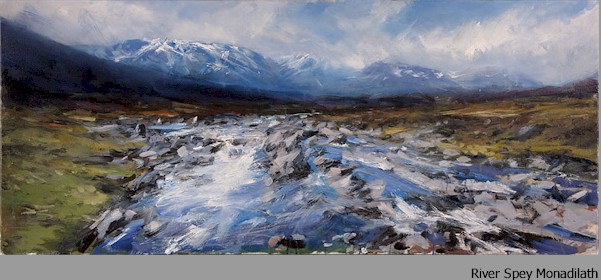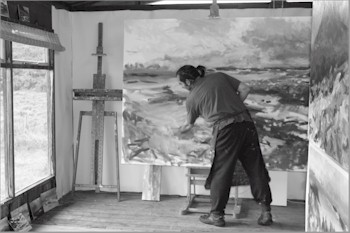
 Publications Publications"In Wild Places" - Essay by Robin Capon "Sublime Wilderness" - Essay by Kevin Dagg "Jonathan Shearer - New Paintings"- Essay by Georgina Coburn |
|
|
Sublime Wilderness - Essay by Kevin Dagg All day we wait, struggling against a dreik day in November, when at the eleventh hour, the cloud finally lifts it's veil and a sudden diffused light pierces through the clouds to illuminate the sky behind the mountains. Drops of water on the Autumn grass catch the light and intensify the golden ochre's and vermilion. Tiny fragments of clouds lie on the ground at our feet, captured in the pools as if they've fallen from the sky. In the distance enshrouded with mist the red Cuillins stand brooding and defiant against the grey sky. It's a magical moment but there is no time to paint so we stand surveying the scene. It can have lasted all but 10minutes but Jon's eye has captured the moment and will become the inspiration for a whole series of works.  It has been said that Jon endlessly roams the landscape in search of
inspiration whereas it is closer to say that the paintings are a result
of short expeditions in search of wilderness. His is not the eye grown
weary through familiarity. "Images live with you" or at least they live
with Jon. In fact they seem to haunt him. Walks are re-lived in the
minds eye, conditions recreated and emotions are stirred.Passionate and
moody, Jon's temperament is ideally suited to the Scottish environment.
He is genuinely excited by it, it moves him, awakening his passion.
Every trip is an adventure, every painting has a story. It has been said that Jon endlessly roams the landscape in search of
inspiration whereas it is closer to say that the paintings are a result
of short expeditions in search of wilderness. His is not the eye grown
weary through familiarity. "Images live with you" or at least they live
with Jon. In fact they seem to haunt him. Walks are re-lived in the
minds eye, conditions recreated and emotions are stirred.Passionate and
moody, Jon's temperament is ideally suited to the Scottish environment.
He is genuinely excited by it, it moves him, awakening his passion.
Every trip is an adventure, every painting has a story.. Working in sketchbooks and on small boards he is able to respond quickly to the changes in light- for this must be Jon's main obsession. The atmosphere and mood become as important as the scenery. He is trying to capture a some of the transience of nature exploring the way light transforms a scene from one moment to the next, chasing the unattainable. An impossible task to express the transient and fleeting but, like the impressionist preoccupation , it is a rich and challenging seam. In the sketches there is a hard won confidence. Whether it be a delicate watercolour or an austere tonal study, each sketch is trying to capture a particular quality. Moving from sketchbook to board he works on several images at a time even swapping between oil and watercolour to find the most suitable medium. He works quickly to block in the general mass, responding intuitively to the changing conditions. Not every sketch is successful but they don't have to be, it is precisely this freedom to take risks, the unconscious response to the landscape which gives the work it's vitality. Back in the studio Jon re-enacts his experiences in his head again and again as the drama unfolds on the canvass. The camera might be used to confirm details but the sketches are used to capture the atmosphere. The action of painting, the history, the marks and movement are still evident in the work. He has become adept at translating the gestures and freshness of the sketches into larger scale paintings. Brushstrokes snake across the canvass with childlike abandon. Close up, they are about colour but standing back from the canvass the colours imperceptibly blend and the scene unfolds. They are not tied down by specifics. The focus has been softened in order to see the bigger picture. The moments are not fixed but somehow changing. As well as the majestic mountain ranges of Scotland he is also drawn to the open expanses of Sutherland and Rannoch moor. Once again his search is to understand the way light breaks down, analysing the scene, looking for the hints and reflections of colour. He is trying to capture the cusp where land rises to meet sky and the two merge. Perhaps this is what Jon means when he talks of harmony, when colours co-exist to give the feeling and depth. When he discusses the sky he talks of the touch of vermilion, the hint cobalt blue, the raw umber. These are specifics, like an alchemists code they are informed by clues from countless artist who have gone before. Recent breakthroughs owe a great deal to the technical analysis of Horatio McCulloch and the fresh on-site sketches of Landseer. Countless others have been here before and Jon is an artist trying to follow in the footsteps of the true Romantic painters of the British landscape. For me Jon's strength is when he is describing a scene quickly. He has a sense of drama and at times he can capture a moment or a quality of light with an expressive gesture or brushstroke. This is not the cold eye of the camera lens, this is the eye of the artist editing the superfluous details in order to arrive at the essence of a scene. Their ambiguity is their strength, leaving something to the imagination, allowing the viewer to empathise with the work. Perhaps it is a particular weather condition or the way light is illuminating a landscape that captures our imagination. The viewer can respond to different aspects of the work and this surely must be their triumph. At times Jon's paintings capture something of the atmosphere. The landscape becomes the backdrop and the clouds and light provide the drama. At their very best the paintings reflect and express man's emotions and can be likened to the works of Keats and Wordsworth. Of course it is a romanticised notion of landscape, but this has always been the case. Artists have defined our notion of landscape and we now routinely refer to pleasant views as picturesque. Gone are the telegraph poles the roads and pine forests. But areas of managed wilderness still exist in Scotland and for me his is an escapism I can adhere to. Kevin Dagg |
|